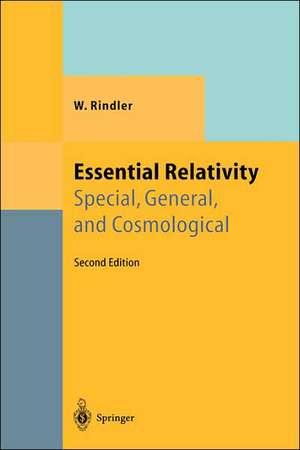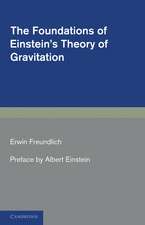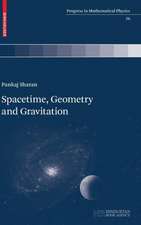Essential Relativity: Special, General, and Cosmological: Theoretical and Mathematical Physics
Autor W. Rindleren Limba Engleză Hardback – 14 iun 1977
Din seria Theoretical and Mathematical Physics
- 20%
 Preț: 697.22 lei
Preț: 697.22 lei - 18%
 Preț: 744.84 lei
Preț: 744.84 lei - 20%
 Preț: 699.50 lei
Preț: 699.50 lei -
 Preț: 396.82 lei
Preț: 396.82 lei - 15%
 Preț: 721.06 lei
Preț: 721.06 lei - 18%
 Preț: 1120.68 lei
Preț: 1120.68 lei -
 Preț: 398.35 lei
Preț: 398.35 lei - 15%
 Preț: 643.65 lei
Preț: 643.65 lei - 15%
 Preț: 508.60 lei
Preț: 508.60 lei - 20%
 Preț: 652.54 lei
Preț: 652.54 lei - 15%
 Preț: 646.75 lei
Preț: 646.75 lei - 15%
 Preț: 654.12 lei
Preț: 654.12 lei - 15%
 Preț: 649.87 lei
Preț: 649.87 lei -
 Preț: 396.24 lei
Preț: 396.24 lei - 15%
 Preț: 653.14 lei
Preț: 653.14 lei - 18%
 Preț: 960.78 lei
Preț: 960.78 lei - 15%
 Preț: 529.92 lei
Preț: 529.92 lei - 18%
 Preț: 1127.78 lei
Preț: 1127.78 lei - 18%
 Preț: 1548.71 lei
Preț: 1548.71 lei - 15%
 Preț: 551.53 lei
Preț: 551.53 lei - 18%
 Preț: 1002.75 lei
Preț: 1002.75 lei -
 Preț: 396.02 lei
Preț: 396.02 lei - 15%
 Preț: 648.89 lei
Preț: 648.89 lei - 18%
 Preț: 783.35 lei
Preț: 783.35 lei - 18%
 Preț: 973.38 lei
Preț: 973.38 lei - 18%
 Preț: 907.90 lei
Preț: 907.90 lei - 15%
 Preț: 655.78 lei
Preț: 655.78 lei - 18%
 Preț: 1118.93 lei
Preț: 1118.93 lei -
 Preț: 390.25 lei
Preț: 390.25 lei - 15%
 Preț: 663.79 lei
Preț: 663.79 lei - 15%
 Preț: 653.79 lei
Preț: 653.79 lei - 15%
 Preț: 645.28 lei
Preț: 645.28 lei - 15%
 Preț: 604.23 lei
Preț: 604.23 lei - 15%
 Preț: 639.25 lei
Preț: 639.25 lei -
 Preț: 395.25 lei
Preț: 395.25 lei - 15%
 Preț: 589.33 lei
Preț: 589.33 lei - 19%
 Preț: 543.19 lei
Preț: 543.19 lei - 15%
 Preț: 594.24 lei
Preț: 594.24 lei - 18%
 Preț: 911.17 lei
Preț: 911.17 lei - 18%
 Preț: 957.75 lei
Preț: 957.75 lei -
 Preț: 409.13 lei
Preț: 409.13 lei - 15%
 Preț: 532.23 lei
Preț: 532.23 lei
Preț: 590.81 lei
Preț vechi: 695.08 lei
-15% Nou
Puncte Express: 886
Preț estimativ în valută:
113.06€ • 120.89$ • 94.26£
113.06€ • 120.89$ • 94.26£
Carte tipărită la comandă
Livrare economică 18 aprilie-02 mai
Preluare comenzi: 021 569.72.76
Specificații
ISBN-13: 9783540079705
ISBN-10: 354007970X
Pagini: 308
Ilustrații: XV, 286 p.
Dimensiuni: 155 x 235 x 22 mm
Greutate: 0.61 kg
Ediția:2nd ed. 1977
Editura: Springer Berlin, Heidelberg
Colecția Springer
Seria Theoretical and Mathematical Physics
Locul publicării:Berlin, Heidelberg, Germany
ISBN-10: 354007970X
Pagini: 308
Ilustrații: XV, 286 p.
Dimensiuni: 155 x 235 x 22 mm
Greutate: 0.61 kg
Ediția:2nd ed. 1977
Editura: Springer Berlin, Heidelberg
Colecția Springer
Seria Theoretical and Mathematical Physics
Locul publicării:Berlin, Heidelberg, Germany
Public țintă
ResearchCuprins
1 The Rise and Fall of Absolute Space.- 1.1 Definition of Relativity.- 1.2 Newton’s Laws.- 1.3 The Galilean Transformation.- 1.4 The Set of All Inertial Frames.- 1.5 Newtonian Relativity.- 1.6 Newton’s Absolute Space.- 1.7 Objections to Newton’s Absolute Space.- 1.8 Maxwell’s Ether.- 1.9 Where is Maxwell’s Ether?.- 1.10 Lorentz’s Ether Theory.- 1.11 The Relativity Principle.- 1.12 Arguments for the Relativity Principle.- 1.13 Maxwellian Relativity.- 1.14 Origins of General Relativity.- 1.15 Mach’s Principle.- 1.16 Consequences of Mach’s Principle.- 1.17 Cosmology.- 1.18 Inertial and Gravitational Mass.- 1.19 The Equivalence Principle.- 1.20 The Semistrong Equivalence Principle.- 1.21 Consequences of the Equivalence Principle.- 2 Einsteinian Kinematics.- 2.1 Basic Features of Special Relativity.- 2.2 On the Nature of Physical Laws.- 2.3 An Archetypal Relativistic Argument.- 2.4 The Relativity of Simultaneity.- 2.5 The Coordinate Lattice.- 2.6 The Lorentz Transformation.- 2.7 Properties of the Lorentz Transformation.- 2.8 Hyperbolic Forms of the Lorentz Transformation.- 2.9 Graphical Representation of the Lorentz Transformation.- 2.10 World-picture and World-map.- 2.11 Length Contraction.- 2.12 Length Contraction Paradoxes.- 2.13 Time Dilation.- 2.14 The Twin Paradox.- 2.15 Velocity Transformation.- 2.16 Proper Acceleration.- 2.17 Special Relativity without the Second Postulate.- 3 Einsteinian Optics.- 3.1 The Drag Effect.- 3.2 The Doppler Effect.- 3.3 Aberration and the Visual Appearance of Moving Objects.- 4 Spacetime and Four-Vectors.- 4.1 Spacetime.- 4.2 Three-Vectors.- 4.3 Four-Vectors.- 4.4 Four-Tensors.- 4.5 The Three-Dimensional Minkowski Diagram.- 4.6 Wave Motion.- 5 Relativistic Particle Mechanics.- 5.1 Domain of Sufficient Validity of Newton’sLaws.- 5.2 Why Gravity Does not Fit Naturally into Special Relativity.- 5.3 Relativistic Inertial Mass.- 5.4 Four-Vector Formulation of Relativistic Mechanics.- 5.5 A Note on Galilean Four-Vectors.- 5.6 Equivalence of Mass and Energy.- 5.7 The Center of Momentum Frame.- 5.8 Relativistic Billiards.- 5.9 Threshold Energies.- 5.10 Three-Force and Four-Force.- 5.11 De Broglie Waves.- 5.12 Photons. The Compton Effect.- 5.13 The Energy Tensor of Dust.- 6 Relativity and Electrodynamics.- 6.1 Transformation of the Field Vectors.- 6.2 Magnetic Deflection of Charged Particles.- 6.3 The Field of a Uniformly Moving Charge.- 6.4 The Field of an Infinite Straight Current.- 7 Basic Ideas of General Relativity.- 7.1 Curved Surfaces.- 7.2 Curved Spaces of Higher Dimensions.- 7.3 Riemannian Spaces.- 7.4 A Plan for General Relativity.- 7.5 The Gravitational Doppler Effect.- 7.6 Metric of Static Fields.- 7.7 Geodesics in Static Fields.- 8 Formal Development of General Relativity.- 8.1 Tensors in General Relativity.- 8.2 The Vacuum Field Equations of General Relativity.- 8.3 The Schwarzschild Solution.- 8.4 Rays and Orbits in Schwarzschild Space.- 8.5 The Schwarzschild Horizon, Gravitational Collapse, and Black Holes.- 8.6 Kruskal Space and the Uniform Acceleration Field.- 8.7 A General-Relativistic “Proof” of E = mc2.- 8.8 A Plane-Fronted Gravity Wave.- 8.9 The Laws of Physics in Curved Spacetime.- 8.10 The Field Equations in the Presence of Matter.- 8.11 From Modified Schwarzschild to de Sitter Space.- 8.12 The Linear Approximation to GR.- 9 Cosmology.- 9.1 The Basic Facts.- 9.2 Apparent Difficulties of Prerelativistic Cosmology.- 9.3 Cosmological Relativity: The Cosmological Principle.- 9.4 Milne’s Model.- 9.5 The Robertson-Walker Metric.- 9.6 Rubber Models, Red Shifts, andHorizons.- 9.7 Comparison with Observation.- 9.8 Cosmic Dynamics According to Pseudo-Newtonian Theory.- 9.9 Cosmic Dynamics According to General Relativity.- 9.10 The Friedmann Models.- 9.11 Once Again, Comparison with Observation.- 9.12 Mach’s Principle Reexamined.- Appendices.- Appendix I: Curvature Tensor Components for the Diagonal Metric.- Appendix II: How to “Invent” Maxwell’s Theory.- Exercises.














